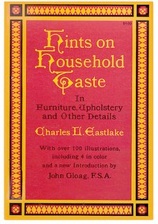
The Weeks House: An Eastlake Victorian

Charles Eastlake and the Eastlake Style
During the latter half of the nineteenth century the Industrial Revolution opened up access to abundant material wealth for a growing middle class in America. Wood was plentiful and cheap. Balloon frame construction and machine-made nails speeded up construction. All these forces fed the exuberance of Victorian architecture.
Victorian architecture encompasses many styles, including the Eastlake Style. The Eastlake Style was part of a movement which began in England and came to America by the 1870s. It is so named because of the popularity of a book written by English architect Charles L. Eastlake entitled Hints on Household Taste in Furniture, Upholstery, and Other Details. The book was reprinted in America and became so popular it required six editions in eleven years.
To some historians, Eastlake Style is classified as a separate style, while others classify it as a decorative style of ornament found on other Victorian styles, such as the Italianate or Stick styles. The Weeks House is referred to by some historians as “Italianate with Eastlake embellishments”, and perhaps its most prominent Italianate feature is the distinctive cornice which caps the structure.
Eastlake Style is largely the product of chisel, gouge, the power lathe and the mechanical jigsaw. Porch posts and railings turned on a mechanical lathe often have the appearance of heavy legged furniture of the period. (Indeed, Eastlake furniture complemented the architecture of the period, and furniture motifs abound in much Eastlake building ornament.) Large curved brackets and other stylized elements were placed at every corner or turn along the facade of a structure. Rich 3-dimensional effects were achieved by building up layers of small planks cut to various sizes and placed over the exterior walls, and by the use of perforated screens and lattice work at gables and elsewhere. Curved archways articulated the entranceways. You will find many of these features on the Weeks House.
Ornament became more geometric in contrast with the more curvilinear ornament found in the Queen Anne Style. Mr. Eastlake popularized the use of 3 foot high wainscoting around the principal rooms, which in turn led to a new 3 part horizontal wall treatment consisting of wainscot at the bottom, a frieze, cornice or picture rail near the top, and a section called the field in between. The refinements to wainscoting led to the development of wallpapers that could imitate dado, field and frieze patterns with a heavy embossed texture. Lincrusta was a wallpaper used to this effect, which you see in the entry area of the Weeks House. Lincrusta was an invention of an Englishman, Frederick Walton, whose father pioneered the use of linoleum flooring. Surprisingly, Lincrusta is still manufactured in England today by the original company.
Eastlake structures are typically one to two stories, with steeply pitched roofs, deeply set gables, asymmetrical facades, and rectangular windows.



The Eastlake Style reached its highest development in San Francisco and surrounding areas, due to the abundant supply of redwood that could be turned, chamfered, and incised. Ironically, Mr. Eastlake scolded the citizens of San Francisco in a newspaper article, lambasting the flamboyant architectural style that now bore his name. He also disavowed any connection with a wide variety of manufactured furniture produced in America and advertised as “Eastlake Style”. A reading of Mr. Eastlake’s book may reveal the origins of this conflict, because his ideas were (however ironic this may appear today) a movement toward simplicity in ornament, and a celebration of the worker’s craft, ideas which can only be understood in the context of prevailing styles at the time of his book.


